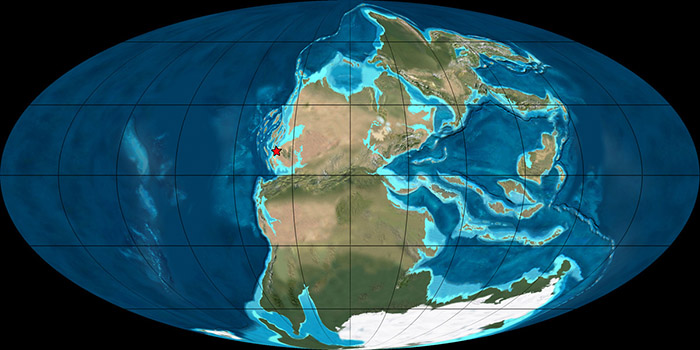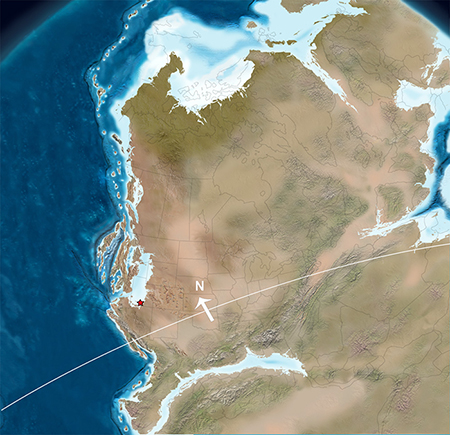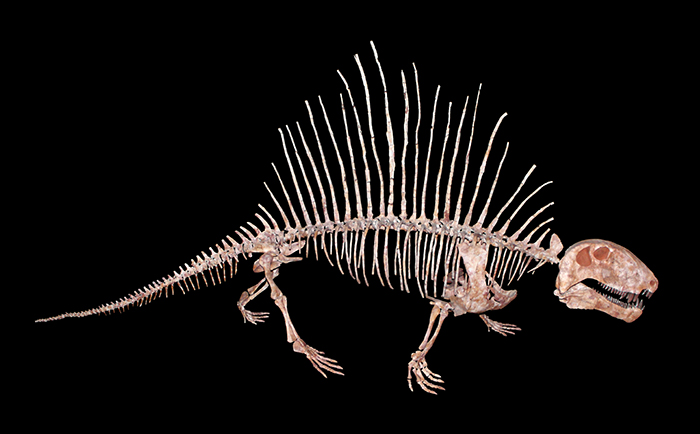
Map of Continents Through Time

Time in History: 254.5 million years ago (Permo-Triassic Border)
Environment Parameters & Graphs of Carbon & Oxygen
|
 |
Question of the Day:
What percent of all living things have gone extinct since the beginning of on life on earth?
Key Concepts
Dispatch - Day 1 The Greatest Mass Extinction:
Outside of Kanab, in southern Utah, there is a long fence on the side of the road, a deer fence designed to keep the animals from crossing the highway. It is a boundary, and in its small way prevents the untimely doom of the deer. Today it also enclosed the Youth Ambassadors in the Grand Staircase Escalante National Monument, and as they ran they learned about the natural boundary in the rock here. Something not man made; a boundary that divides the Permian and Triassic eras, and represents one of the earth’s greatest extinction events 254.5 million years ago. A time when far more than a few deer died. The line dividing the eras is as clear as the fence. It is a literal streak through the rock in Buckskin Gultch that ambassadors stepped over with a single stride. One foot stood on grayish rock, that resembled a choral reef, full of fossils of marine species that used to sit at the bottom of a shallow ocean. The next foot crossed to a sandy orange rock, burning in the afternoon sun, but representing an era of far greater heat than today when the temperature sat at 135 degrees Fahrenheit and oxygen content was a quarter less than it is today. These extreme conditions wiped out the majority of species on earth, particularly in the marine world, and as a result the orange rock was fittingly empty of fossils. But a few survived this extinction, and from them new life evolved. And it is similar for the deer fence. Under the highway leading outside Kanab there are a few spots where culverts lead under the road. These are safe byways to allow deer to cross safely beneath the traffic. It showed the Youth Ambassadors that even the most pronounced boundary’s – even the most pronounced extinctions - can have space for life to get through.
| Daily Video | Expert Video |
|---|---|
Photos of the Day
Coming Soon!
Character of the Day: Dimetrodon
Dimetrodon was a large carnivorous four legged animals that grew up to 10 feet (3.2 meters) in length and 250 kilograms (550 lbs). Dimetrodon were common in the land that became the Southwestern United States, and would have been seen in the area of the Grand Staircase Escalante National Monument during the Permian Period. Although reptile-like in appearance, the Dimetrodon was more closely related to mammals. As such, Dimetrodon belongs to a group called “mammal-like reptiles”.
Youth Ambassador Activity
Dr. Alan Titus’ sets the stage for the days run, and what the youth ambassadors will learn from the terrain under their feet.
One thing to bear in mind, when you’re not thinking about the hardships you’re going through, you’re actually running through landscapes formed in rocks that record some pretty seminal events in earths history.
Camp rocks were early Triassic and were laid down in the aftermath of the worst mass extinction our planet ever experienced. The conditions at the time after the extinction were very similar to North Africa so imagine your self here running 250 million years ago across a north African like landscape. Low in elevation, extremely hot, extremely dry, sand dunes, arid tidal flats, salt pans, things like that.
Day time temperatures this time of year are up in to the 130-135 degree range Fahrenheit, very little precipitation, and what precipitation we did get would have been monsoonal, sort of heavy in one season and dry for rest of the year
As you ascend Buckskin Mountain over there which is the ridge on the skyline, you’ll be passing over the extinction horizon and in to marine rocks that record the pre-extinction world that we’ll get very intimate with at the end of the day. We’ll sort of analyze the lost world, the world that died, first, and then we’ll look at the world that resurrected itself in the aftermath of the disaster.
I’d like you to, as you’re running through this modern landscape, to contemplate what it might have been like 250-260 million years ago as these great cataclysms are playing themselves out in earths history and we’re seeing one of the great cycles that shaped our modern world as it unfolds.
So are you ready to see one of the greatest disasters in Earth’s history?
And in the subsequent days we’ll actually get to see the recovery from that and the glimmer of hope at the end of the tunnel.